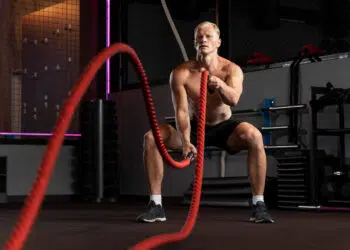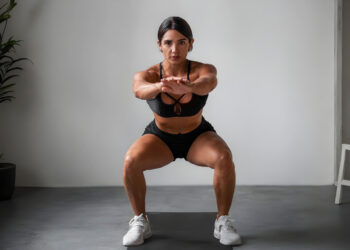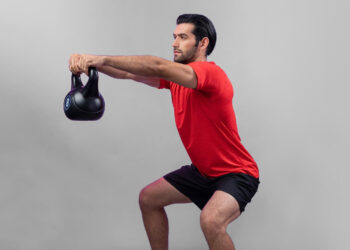I’ve been a personal trainer for over 30 years. During that time, I’ve often been asked how to do cardio without using the legs. At first, this was quite a head-scratcher. After all, most of the best cardio activities ONLY use the legs, e.g., running, cycling, stepping, etc.
However, there are actually plenty of ways to do cardio that don’t involve much, if any, lower body engagement.
But why do so many people want to do upper-body cardio? It turns out there are several reasons. These include:
- Foot, ankle, knee, and hip injuries
- Back injury
- Lingering fatigue or soreness from previous leg workouts
- The need for upper body conditioning, i.e., for sports
- Workout variety and enjoyment
So, while running, cycling, and rowing are effective cardio exercises, they aren’t the only way to train your heart, lungs, and circulatory system. That’s good news because research tells us that cardio training is critical for long-term health and can help you lose fat and reach your ideal weight (1). Subsequently, most people need to do more of it.
In this article, I share nine ways to do cardio without using your legs. These are based on my many years of personal experimentation plus feedback from hundreds of personal training clients.
The Best Cardio Workouts That Don’t Use Your Legs
So, you want to do cardio without using your legs? Based on my extensive fitness industry experience, these are some of the best options!
Level Up Your Fitness: Join our 💪 strong community in Fitness Volt Newsletter. Get daily inspiration, expert-backed workouts, nutrition tips, the latest in strength sports, and the support you need to reach your goals. Subscribe for free!
1. Upper body air-bike or ski-erg
Air-bikes and ski-ergs use large fans for resistance. Most gyms have these machines, and they’re available for home purchase, too. While air-bikes and ski-ergs typically provide a full-body workout, you can operate both using your upper body only.
You can do steady-state and interval training on these machines. Plus, because of the variable air resistance, your workouts can be as easy or intense as needed. But don’t worry if you don’t have access to an air-bike or ski-erg. There are plenty more ways to do cardio without using your legs.
2. Upper body bike
More and more equipment manufacturers are making upper-body bikes. Gyms often have them, and they’re available for home purchase. Most have removable seats for easy wheelchair access. Others are made for tabletops, making them portable and perfect for home use.
Upper-body bikes work your chest, back, shoulders, and arms. You’ll also need to brace your core to stabilize your spine. As such, they provide a comprehensive upper-body workout while also increasing your heart and breathing rate.
You can use an upper-body bike for all types of cardio, from Tabatas to HIIT to low-intensity steady-state training. And don’t mistake this for an easy workout – it’s anything but. In my experience, this is one of those exercises you’ll love to hate. By that I mean you’ll love the effects but hate how humbling it is.
3. Seated battle rope intervals
Battle ropes are long lengths of heavy rope you lift and swing for an intense conditioning workout. They are mainly used while standing, so your legs usually get in on the action. However, park your butt on a bench or chair, and you can get a great workout using just your upper body.
Because battle rope exercises are so challenging, they’re generally best for interval training. For example, do two-handed rope slams for 30 seconds, rest for 60 seconds, and repeat ten times.
4. Upper body circuits
Circuit training involves doing several resistance exercises back-to-back. This training method has been around since the 1950s, and a meta-analysis published on PubMed suggests that it’s an effective way to improve cardiovascular fitness, body composition, strength, and muscular endurance (2). In short, it’s super versatile and efficient.
Circuit workouts often include leg exercises, but there is no rule to say they must. While you can create your own upper-body circuit workouts, here’s one to get you started.
| # | Exercise | Time | Transition |
| 1 | Push-ups | 45 seconds | 15 seconds |
| 2 | Lat pulldowns | 45 seconds | 15 seconds |
| 3 | Shoulder press | 45 seconds | 15 seconds |
| 4 | Seated row | 45 seconds | 15 seconds |
| 5 | Dumbbell curl and press | 45 seconds | 15 seconds |
| 6 | Kneeling cable crunch | 45 seconds | 15 seconds |
Use a load that takes you close to muscular failure in the allotted time. Going too heavy will mean fewer reps, reducing the cardiovascular impact of the workout. Rest 1-2 minutes between laps and perform 3-5 circuits in total.
5. Boxing
While boxing does involve your legs, they’re not doing anywhere near the same amount of work as your upper body. In fact, you can remain relatively stationary and still throw punches. This is not a good strategy during a boxing bout, as you’re more likely to get hit. However, it means you can still get a good workout using mostly your arms.
You can do:
- Heavy bag work
- Shadow boxing
- Speedball training
Three-minute rounds with one-minute rest are particularly taxing and mirror the physiological demands of boxing. Just keep your feet relatively still so your upper body does the majority of the work.
6. Sledgehammer training
Sledgehammer training is one of my favorite upper-body cardio workouts. It’s not just effective – it’s fun! To do this type of workout, you’ll need a regular sledgehammer and an old SUV tire. A pair of work gloves to protect your hands is also a good idea.
Then, armed with your hammer, simply swing and hit your tire for time or reps. There are several ways you can do sledgehammer training for cardio, including
- Intervals, e.g., 30 seconds work, 60 seconds rest.
- Density blocks, e.g., five minutes or 100 non-stop swings
- Tabatas, i.e., 20 seconds work, 10 seconds rest, for eight sets
- Pyramids, e.g., 20, 19, 18, 17, 16, 15, etc., swings
Here’s a very old video of yours truly doing a Tabata sledgehammer workout:
7. Arms-only rowing machine
Rowing is usually a full-body activity. Each stroke starts with a powerful leg extension called the drive. You then transition to pulling with your arms once you’re moving. Using your arms too much or too soon is considered poor form.
However, you can get a very effective cardio workout by keeping your legs stationary and only using your arms. While you won’t travel as far or as fast, you’ll still increase your heart and breathing rate and burn plenty of calories.
Level Up Your Fitness: Join our 💪 strong community in Fitness Volt Newsletter. Get daily inspiration, expert-backed workouts, nutrition tips, the latest in strength sports, and the support you need to reach your goals. Subscribe for free!
You can do interval or LISS training in this fashion. However, make sure you keep your core braced and your torso upright throughout to avoid straining your lower back.
8. Pull-buoy swimming
Swimming is another of those activities that most people think of as a full-body exercise. After all, all the accepted swim strokes involve kicking your legs as you pull with your arms. A powerful leg kick allows you to swim faster and further with less effort.
However, recreational and competitive swimmers often swim using just their arms. They do this to improve their technique and strengthen their chest, shoulders, and back muscles.
You don’t have to be an experienced athlete to do arms-only swimming. In fact, it’s a great way to get an upper-body cardio workout, even if you only swim infrequently.
One of the best ways to remove your legs from swimming is by using a pull buoy. This is a special float that you clamp between your legs. Using a pull buoy stops you from kicking
and also keeps them afloat so they won’t drag you to the depths or slow you down.
Pull buoys are cheap, light, and readily available, making them ideal for occasional or regular use. Just put the float between your legs and swim as usual. You can use a pull buoy for freestyle, breastbone, and backstroke.
9. Kayaking and paddleboarding
I don’t know about you, but I prefer to do as much of my cardio as possible outside. Being out in the fresh air and sunshine is energizing, healthier, and more enjoyable than slogging away indoors on a stationary bike.
Of course, cycling, running, hiking, etc., involve your legs, so they’re off the menu. However, there are still some upper-body cardio options to explore.
Two of my favorite upper-body outdoor cardio options are kayaking and paddleboarding. Both emphasize your chest, back, shoulders, and arms, and lower body engagement is minimal.
Kayaking is done while seated. As such, you only need to use your legs to walk down to the shore and get in your boat. In contrast, you paddleboard while standing, so you’ll need to use your legs to a degree. However, you do most of the work with your upper body and core, so your legs aren’t overly involved.
In my experience, kayaking is easier to pick up, but paddleboarding is more enjoyable and rewarding. My advice is to try them both and see which one you prefer.
The author out on his paddleboard:
Cardio Without Using Your Legs – FAQs
Do you have a question about doing cardio without using your legs? No problem, because I’ve got the answers! Need more information? Please drop me a line in the comments section below, and I’ll get back to you ASAP.
1. Is upper-body cardio as effective as regular cardio?
There is no reason to think that upper-body cardio is any less effective than lower-body or full-body cardio. Your upper body muscles need oxygen just like your legs. As such, your heart and breathing rate will increase regardless of whether you’re using your lower body or upper body.
2. Will upper-body cardio increase muscle size?
Cardio activities emphasize your type 1 slow-twitch muscle fibers. These fibers are built for endurance and have a small diameter and low strength potential. While they do get bigger in response to training, size increases are minimal. Consequently, upper-body cardio probably won’t build much muscle.
That said, more enduring fibers mean you should be able to pump out more reps and recover faster between sets. This could make your strength training workouts more effective and efficient. As such, upper-body cardio could indirectly boost your gains.
3. Are upper body cardio exercises safe?
Most upper-body cardio exercises involve relatively low amounts of muscular and skeletal stress. As such, they’re pretty safe, and injury rates are low. However, repetitive movements like swimming and battle ropes can lead to joint wear and tear. This can cause inflammation and could lead to chronic injuries like tendonitis.
Avoid such problems by warming up before and cooling down after every workout. Changing exercises from time to time will also help. You should also pay special attention to your rotator cuff, weakness of which is a common source of shoulder joint pain.
Closing Thoughts
Whether you are suffering from post-squat workout muscle soreness or have a lower-body injury, you can still do your cardio. With all the options outlined in this article, you should have no problem finding an activity to suit your needs and goals.
If you train in a gym, you can use a rower, air-bike, or ski-erg with just your arms. In contrast, if you prefer to exercise outdoors, you can try kayaking, paddleboarding, or open-air pull buoy swimming. Home exercisers can do upper-body calisthenic circuits or sledgehammer training.
Each method will elevate your heart and breathing rate while burning plenty of calories. They’re good for improving your fitness and even better for your health. Plus, they’ll help you burn fat and get lean.
So, regardless of your situation, you can still do cardio without running, cycling, or using an elliptical.
References
- Mersy DJ. Health benefits of aerobic exercise. Postgrad Med. 1991 Jul;90(1):103-7, 110-2. doi: 10.1080/00325481.1991.11700983. PMID: 2062750.
- Ramos-Campo DJ, Andreu Caravaca L, Martínez-Rodríguez A, Rubio-Arias JÁ. Effects of Resistance Circuit-Based Training on Body Composition, Strength and Cardiorespiratory Fitness: A Systematic Review and Meta-Analysis. Biology (Basel). 2021 Apr 28;10(5):377. doi: 10.3390/biology10050377. PMID: 33924785; PMCID: PMC8145598.











Thank you for this informative article on arms-only cardio. I am a 55 year old male, getting back into cardio workouts after years of sedentary living. Unfortunately, I cannot do the kind of physical activity I did in my youth, because I am all busted up with severe motorcycle injuries, so I am limited to using just the arm bars on my Schwinn Airdyne exercise bike (my favorite exercise bike of all time). I’ve been doing it consistently for several weeks, making good and constant improvement, and feeling really good. I’ve been doing 5-6 days per week, and I have slowly and carefully built up to where I can do 30 minutes per session (5 minutes light-intensity warm-up, 20 minutes moderate intensity, 5 minutes light intensity cool-down). My big question at this point is: Do I need to allow for more than 24 hours recovery time between workouts, since I am working out with arms only, and not legs? I’ve been feeling really good, and it doesn’t seem like I need more than a day of recovery, but as I improve I want to increase my intensity and duration, so I want to make sure that I can still do a good solid cardio workout every day, without over-straining my arms as I work them harder.
Hey George,
One the of the first gyms I ever worked out in had Schwinn AirDynes – brilliant bikes! I reckon they’re ideal if you want to do mainly upper body cardio.
Re. days off – I suggest listening to your body. If you feel okay, there is no reason to skip a day of you don’t want to. Conversely, don’t be afraid to take an extra rest day if your body tells you it needs one.
Here’s an article with some of the signals that you need an extra rest day. https://fitnessvolt.com/rest-day/
You might also benefit from alternating longer/harder workouts with shorter workouts. This is another great way to train daily without tiring yourself out. E.g., work up to 35-40 minutes on your long days, but do just 15-20 easy minutes on your short days. Alternative between these two workouts, taking days off when needed.
I hope that helps, and good luck on your journey back to fitness.
Patrick.